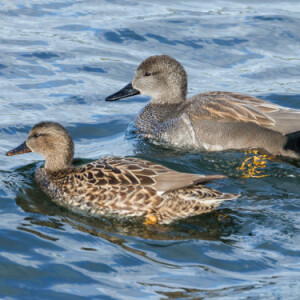Springy
I had to run an errand in Coventry this afternoon, and as it was bright and sunny I thought I'd swing on up to Draycote Water afterwards, to see if I could find the long-tailed duck and the pair of juvenile great northern divers that have been overwintering there. In the event I didn't spot any of the three, which was a little bit disappointing, but you can't currently walk all the way around the reservoir because new pipework is being installed, and as the area is large and the birds relatively small and mobile, I wasn't too surprised.
I'm posting two birds tonight that I haven't featured here for a while. The main image, which is R's favourite, was taken in the Conservation Area at the eastern end of the lake, when a little flock of long-tailed tits suddenly swooped across in front of me to search the hedgerow for food. These busy, noisy little birds - which always make me think of children's fluffy toys - are always a pleasure to see, but they're so active and fast that they're not especially easy to photograph, and I was impressed that the camera latched onto this one in the split second it paused before changing its perch.
My second photo is a pair of gadwalls, which stand quite high on my list of favourite ducks. The bird closer to the camera is a female, and the one behind, on which I focused, is the male. This species is monogamous, so this will be a bonded pair, but statistically they're unlikely to breed here, as the RSPB estimates that the UK has fewer than 2,000 breeding pairs. In winter though, we host over 30,000 migrant individuals, mainly from Russia, Scandinavia and Iceland, and it's thought that this number is increasing, at the same time as the Russian population is believed to be in decline.
The thing I love about gadwalls is the subtle colouration and patterning of the males. At a distance they can appear to be mainly grey, but when you see them at close quarters they're a positive riot of different patterns: flecks on the head, scales on the breast, and a vermiculated (worm-like) pattern on the flanks, which I assume are designed to confuse the eye of any potential predators. The females resemble female mallards, though they're a little smaller and paler, and in flight both sexes have an obvious white speculum, or wing flash. A fun (and surprising) gadwall fact is that you'll often see them stalking coots, which they like to rob of the water weed that forms a large part of the diet of both species: gadwalls being dabbling ducks, and coots divers, the coots can fetch up plant material that the gadwalls can't reach themselves. In my experience though, coots are pretty aggressive, and I'm not aware of any other bird that's prepared to get between them and their food, so this one fact makes me look at the gadwall in a different light.
I've posted a third photo from today on my Facebook page, if you'd care to see it.


Comments
Sign in or get an account to comment.


